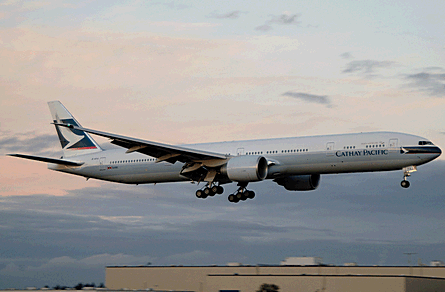Cathay Pacific surprised the markets with its first-half loss as high fuel prices and falling demand took their toll
Asia-Pacific airline earnings have been taking a beating, as generally solid revenue growth has failed to overshadow rising fuel costs at most carriers. And this time it is not just the traditionally weaker players that have been hurting. Consistently strong Cathay Pacific Airways recently joined the list of those airlines operating in the red.
Signs of impending trouble from the Hong Kong-based carrier first surfaced in July, when it issued a profit warning, cautioning investors that its financial results were likely to be "disappointing" this year due to increased fuel costs. But the extent of the trouble was not made clear until a month later, when the airline shocked financial markets with a rare loss for the first half. Despite the July warning, however, analysts were almost universally still expecting a small profit.
Price-Fixing Charge
A big portion of the first-half loss was due to a HK$468 million ($60 million) provision to cover a proposed settlement with the US Department of Justice in its investigations into price-fixing in the international air cargo market.
But Cathay still posted an operating loss before this non-recurring item - and it came despite strong growth in revenue. Turnover was up 22.5% in the first half but operating expenses soared 35%, mainly due to a more than 80% rise in fuel costs.
Cathay typically reports strong earnings - for 2007 a record-high net profit of HK$7.02 billion - and the loss was its first in five years, when it was badly hurt by a sharp drop in demand during the SARS outbreak.
 |
|---|
Chairman Christopher Pratt said in releasing the results that while demand was still strong, ticket prices need to increase and this will have an effect on travel patterns moving forward. He also said Cathay must be careful not to make cuts to its network that are too deep.
"Cathay Pacific is reducing costs where it can but there is a limit to how much cost can be saved before quality and brand are compromised and the service proposition to the customer is changed beyond recognition," says Pratt. "It is thus inevitable that fares for passengers and shippers will have to rise to reflect the new cost of operation. This will be the case across the industry."
Cathay is warning of more potential trouble ahead. It had seen demand holding firm, particularly in the front end of the cabin where it earns much of its revenue, but this is weakening too. Chief executive Tony Tyler said in the carrier's in-house newsletter in September that "in addition to the continued fuel price gloom there are now real concerns about how demand will hold up in the coming months". He added: "We're already seeing some softening in the Hong Kong corporate market, which is worrying because it's our single biggest source of revenue. At the moment this market has almost stopped growing, despite a big rise in capacity."
He also said signs that markets such as the USA and UK could be heading towards recession were cause for further concern. "That would hit us hard. The US generates a big percentage of our revenue and we are highly exposed to the UK market with four long-haul flights a day."
But analysts say it is not all doom and gloom, as Cathay is still better placed than many of its competitors to handle high fuel prices. HSBC Global Research says Cathay is "well positioned in a high fuel cost environment. We believe it has the highest proportion of business travellers amongst the Asian airlines we cover and it has a strong balance sheet".
Source: Airline Business
















